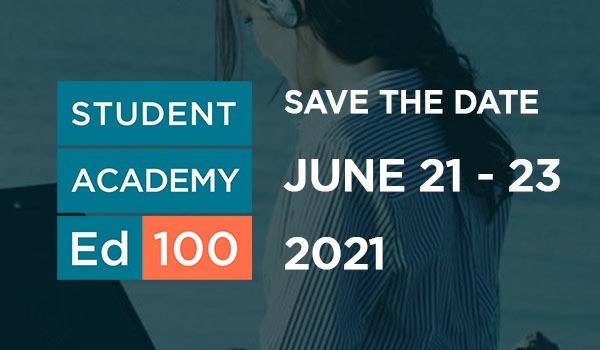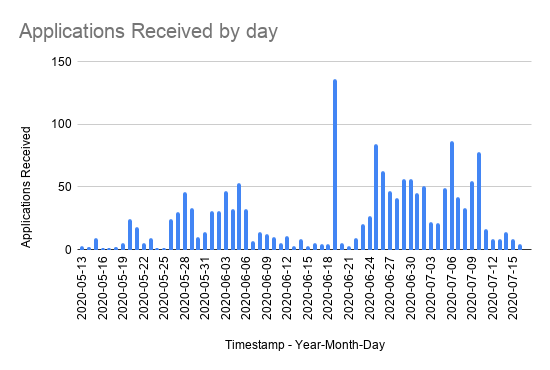La realización de la Academia para Líderes Estudiantiles

It Almost Didn't Happen, Again.
The first-ever Ed100 Academy for California Student Leaders was held online July 20-23, 2020. Over a thousand high school students applied for it, and more than 450 participated through to the end.
This post, the first of a series, tells the story of how the first large online conference for California student leaders came to be. It almost didn't.

Over the coming weeks, subsequent posts in this series will dive into what happened, with links to presentations, resources and survey results. We will also share some of the lasting impact of the conference, with stories that highlight student leaders who benefitted from the conference and the work they are doing now in their school communities and beyond.
Please mark your calendar and ask your school district, your PTSA, and your family to do the same: the 2021 Ed100 Academy for California Student Leaders will be held online June 21-23, 2021.
How the Student Leader Academy Came to Be
Ed100.org was developed mainly for parent leaders, but I wrote it with my teenage self in mind.
I was a high school student in 1983, the year an influential report titled A Nation At Risk was released. The report warned of "a rising tide of mediocrity" in America's schools and it called for bold reforms. Count me in, I thought. My school, like many in the state, had struggled through deep budget cuts and a teacher strike.
A high school counselor suggested that I apply for a new opportunity she had heard about: a student position on the State Board of Education. Pursuing the position connected me to an inspiring network of student leaders. I attended conferences. I learned how to get copies of proposed legislation and drove to Sacramento in my parents' Oldsmobile to comment on it.
I left California after high school and it was many years before I returned to this state and to my interest in the education system, this time as a parent. The school system seemed as troubled as ever. What would it take to improve more deeply, I wondered? I started learning more deeply about the education system and writing about it, developing the content that would ultimately evolve into Ed100.org.
A False Start
In 2019 we planned an online academy, but scrubbed it. Too hard.
In 2019, the year before the pandemic, the Ed100 team discussed the idea of an online conference for California student leaders. It wouldn't be as good as an in-person conference, we reasoned, but it would be better than nothing. We started planning, but in the end, we scrubbed the idea. Although online meetings were possible at the time, they weren't yet universally accepted. Among the problems: a large fraction of students lacked internet access. We had learned from the attempt, but concluded that the idea was probably too big for us to implement successfully. We put the idea on the back burner. We wouldn't pursue it.
Then everything changed, of course.
The conditions were very different in 2020. Distance learning was suddenly commonplace. The pandemic had made it essential for every student to have access to an internet-connected device. Summer-as-usual seemed totally up in the air. The calendar for student leaders was wide open.
Zooming from Zero past 1,000 in Nine Weeks
Now or never, we decided. We had no funds at the ready for a conference, but decided to try anyway.

This summer, Ed100 will be running its first-ever online academy for California student leaders. It will be a free, intensive 3-day Zoom event that connects student leaders with one another and puts them directly in contact with the state's education leaders.
We need talented volunteers to help make this happen. We need help with outreach, project coordination, PR, application review, and with the work of running a big, complex Zoom event. Want to be part of making some history?
In April I placed calls to leaders of a handful of organizations I knew well to gauge interest and gather support: EdSource, Californians for Justice, EdTrust-West, the California Association of Student Councils and Full Circle Fund. Their feedback was cautious, but it was enough.
On May 11, 2020, we sent email to Ed100 subscribers with a "Make a Difference" message at the bottom.
We were lucky. Some very talented volunteers thought students needed a seat at the table. They answered the call.
- Arati Nagaraj, a school board member in Saratoga, brought experience in conference planning and operations.
- Jennifer Johnson brought experience running volunteer teams developed through her work with Full Circle Fund.
- Robin Klau, a marketing professional with social media expertise, had been helping Ed100 for years.
- Carol Kocivar, the longtime co-author of the Ed100 blog, championed the project with the California State PTA and other organizations.
- Paul Richman, a past executive director of the State PTA, helped with introductions to social justice organizations and speakers.
- Matthew Green, a filmmaker, stepped up to help with event production.
But most of that happened later. Some of the first, most formative conversations about the conference were with student leaders of the California Association of Student Councils (CASC), the same organization I had served in decades earlier. The CASC leaders initially decided to pass on the project — it was big and risky, and they were grappling with challenges of their own. They left the door open and joined on as key partners once the details were better fleshed out.
Fortunately, Brenna Pangelinan, the student member of the California State Board of Education, took an early interest in the conference and went on to serve as its host. She helped persuade student leaders from GENup, a new statewide organization of student leaders, that the conference was worth the risk, even with only two months to pull it all together.
EdTrust-West pushed us to set clear goals for the conference, which evolved as events unfolded. From the start, we knew that the conference had to be big, free, and as inclusive as we could make it. Some high schools would be easy to reach; the test of our success would be to involve student leaders from schools that would be hard to reach.
|
Goals of the Ed100 Student Leader Academy |
|---|
|
Educate for credibility: Help high school student leaders throughout California understand how the education system works at a level suitable for engaging in it as a leader. |
|
Connect for impact: Introduce high school student leaders to organizations and programs in the "ecosystem" of California education in a way that leads to action. Connect talent with opportunities. |
|
Reach for equity: Include student leaders from each high school in California. By making this conference free and online, this vision is not merely aspirational. |
|
Accelerate for wisdom: By providing intentional training and fostering connections in the summer, with focus on rising juniors and sophomores, this conference seeks to support the development of strong "pipelines" of knowledgeable student leaders for school site councils, school boards, school organizations and student organizations. |
|
Respect the moment: This conference is being launched in the context of a pandemic and a social awakening about institutionalized racism. Student leaders need to be ready to participate in crafting the response. |
We announced the conference with a simple blog post featuring a big, orange "Apply Now" button. We knew that it would be much harder to reach students after school let out for summer, so we set the first application deadline for June 6. The application, implemented as a Google form, asked students for some information about themselves as leaders, along with their grade level, school name and city, email address and phone number.
Jennifer recruited a small team of five high school and college student interns who would focus on outreach, communication and media. The team developed a target list: all California public high schools with at least 100 students — more than 1,300 schools. We set an audacious goal: include at least one student from at least half that number. (Did we make the goal? You'll find out in a future post in this series…)

Applications began arriving. Each day, members of the team reviewed and cleaned incoming applications, spotting and resolving duplicate entries, fixing recognizable typos, and matching school names to the California School Directory. We followed up with students individually where necessary to ascertain each school's official name and unique ID, known as a CDS code. This was tedious, but important: by knowing which schools were unrepresented we were able to focus our outreach efforts on districts and counties where the invitation to apply had not yet reached student leaders.
About six weeks before the conference opened, the team began meeting every weekday morning via Zoom to stay in sync and manage risks. We coordinated the overall plan using Trello. (Atlassian supported the project by providing a much-appreciated upgrade.) We bought a license for GMass. We used Slack for all communication within the team, reserving email for communication with presenters, partners and students. Arati took charge of scheduling meetings with speakers using Calendly. We used Google Docs to collect bios and slides for a lineup that would grow to 33 speakers.
Students: get your own, grown-up email account.
We learned the hard way that many high school students use an email address provided by their school. These email addresses are often useless, because the school's server is set to block incoming emails. Happily, students tend to have their own phone numbers, which we asked for in the application form. We helped many students recover their application by getting in touch via text. We advised them to reapply with a fully functional, grown-up personal email address associated with their own Google account.
We hoped that we could reach student leaders by appealing to school principals and district superintendents. An email address for every school principal in California is published as public data, and we sent multiple email messages. These messages did reach principals and superintendents in some schools and districts... but in most cases the message, if read at all, never made its way to student leaders.
Dear student leader:
I’m writing to nominate you for the Ed100 Summer Online Academy for California High School Student Leaders.
Student leaders from hundreds of high schools throughout California will participate in this free and unprecedented conference, which will include a who’s-who of amazing speakers and organizations. It’s an opportunity to learn about California’s education system, to examine the ongoing role of racism and inequality in it, and to collaborate on productive options for student leaders to take action. This conference will be held July 20-23. Applications are being accepted NOW (please apply by _____). It is free.
I hope you will accept the honor of representing your school at this conference. It is my honor to nominate you.
Thank you,
Wherever superintendents and principals were unresponsive, the Ed100 intern team tried everything they could think of to reach student leaders. They searched for connections to high school guidance counselors, mostly without luck. (Counselors, scarce to begin with in California high schools, were overwhelmed by the crisis.) They had some success reaching out to PTA leaders on Facebook, Instagram and Twitter. They identified local advocacy groups and approached them for help. In Los Angeles they contacted the offices of school board members and asked their help to spread the word to student leaders in schools they represent.
In all cases, the basic action request was simple: identify specific student leaders and send them an email to nominate them to apply.
The difficulty of this outreach effort reinforced the need for the conference: student leaders in California high schools are profoundly isolated from one another. The education system is not designed to connect students across schools, districts and counties, even in a crisis. Reaching a student leader in one high school rarely helped us reach student leaders in other high schools, even in the same school district or city. These obstacles deepened our conviction. California needs student leaders who are connected. We resolved to double down on that goal.
More To Come!
Our next post in this series will describe what we did to help students connect with one another and with six remarkable organizations that stepped up as partners.
|
Learn More About the 2020 Ed100 Academy for California Student Leaders |
|
|---|---|
|
Program Guide: |
|
|
Preview: |
|
|
Day 1: |
|
|
Day 2: |
|
|
Day 3: |
|
|
Day 4: |
|
Etiquetas de esta publicación
Todas las etiquetas
Academia Khan Acoso acreditación Actitud Administradores Agallas Álgebra Ambiente escolar Aprendizaje Aprendizaje Ampliado Aprendizaje basado en proyectos Aprendizaje socioemocional Artes Asistencia Asociación de Maestros de California Asociación de Padres y Maestros Atención plena Ausencias Bonos de obligación Brecha de desempeño Burbank Calidad Calificación de escuelas Calificaciones en pruebas Cambio Canción Carol Dweck Carrera Cerebro Certificación CHAMP Ciencia Cierre de escuelas Civismo Comparaciones nacionales Concurso Consejeros Consejo escolar Control local Costo de educación Creatividad Crecimiento económico Crucigrama CSBA Currículo común cursos de estudios étnicos Datos Después de clases Día de la Independencia Diálogo dislexia Distritos Diversidad Dotado DREAM Act EACH EdPrezi EdSource EdTech Educación bilingue Educación del carácter Educación especial Educación religiosa Educación sexual Educación universal Elección Elección de escuela Enlaces guía Equidad Escasez de maestros Escuelas católicas Escuelas chárter Escuelas comunitarias Escuelas en casa Escuelas Magnet Escuelas privadas Escuelas religiosas Esfuerzo Estándares Estudiantes en riesgo Estudiantes que están aprendiendo inglés estudiantes sin hogar Estudios étnicos Evaluación Evaluación nacional de progreso educativo Éxito Federal Filantropía Financiamiento Financiamiento local Fondos por categorías Fundaciones educativas Ganadores Gastos Gobierno local Gráfica Grupos de presión Guía para padres líderes Historia Horas de oportunidad Huelga Humanidades Impuestos a la propiedad Impuestos prediales Índice de desempeño académico Indignación Indocumentado Infraestructura Iniciativas Instalaciones Internacional Investigación Jerga Kindergarten La Ley Brown LCFF Lectura Ley Cada Estudiante Triunfa Ley Que Ningún Niño Se Quede Atrás Liderazgo Límites de distritos Litigación Lotería Maestros mantequilla de cacahuate Mapa Mapa del sitio Marcador Matemáticas Medios de comunicación Mejoramiento Continua Mito Mitos Motivación estudiantil Negociación colectiva Negocio Niñez temprana Noticias falsas Nutrición Organizaciones de gestión para escuelas chárter Padres Pandemia Participación de los padres Pedagogía Pensiones personalizado PISA Plan de responsabilidad de control local Planificación Plantilla Población Pobreza Política Política federal Políticas Premio Prescolar Presupuestos Prezi Proposición 13 Proposición 98 Propósito de la educación Pruebas Reclutamiento de maestros Reforma Requisitos ag Responsabilidad Resumen del año Retención de maestros Rigor rompecabezas Rúbrica de evaluación Salario de maestros Salud Salud mental Se necesita ayuda Serrano vs Priest Sindicatos Sorteo SPSA STRS Sueño Suicidio Superintendente Suspensiones Tablero Talento Tamaño de clases Tareas escolares Tasas de graduación Tecnología Tecnología en la educación Tiempo dedicado a la tarea Tiempo en la escuela Trump Universidad Vacunación Vales Valores Vapeando Verano Vídeo Voluntariado Voluntarios Voto Voz del estudiante¡Compartir es vivir!
Restablecer contraseña
Buscar aquí en el contenido del blog y todas las lecciones.
Iniciar sesión con correo electrónico
We will send your Login Link to your email
address. Click on the link and you will be
logged into Ed100. No more passwords to
remember!














Preguntas y comentarios
Para comentar o responder, por favor inicie sesión .